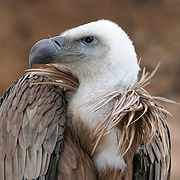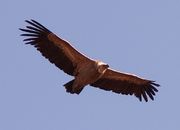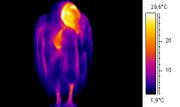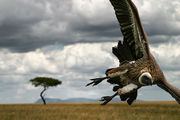Vulture
| Vultures | |
|---|---|
 |
|
| Griffon vulture, Gyps fulvus | |
| Scientific classification | |
| Kingdom: | Animalia |
| Phylum: | Chordata |
| Class: | Aves |
| Families | |
|
Accipitridae (Aegypiinae) |
|


Vultures are scavenging birds, feeding mostly on the carcasses of dead animals. Vultures are found on every continent except Antarctica and Oceania.
Although feeding largely on meat (as opposed to insects and small reptiles), vultures do not generally kill their own prey, which would classify them clearly as a raptor. Because of this, historically they have alternated between being classified as a raptor or as a non-raptor, and have been the subject of extensive DNA testing to test relationships with other birds.
A particular characteristic of many vultures is a bald head, devoid of feathers. This helps to keep the head clean when feeding. Research has shown that the bare skin may play an important role in thermoregulation.[1]
A group of vultures is called a wake, committee, or venue.[2][3] The word Geier (taken from the German language) does not have a precise meaning in ornithology, and it is occasionally used to refer to a vulture in English, as in some poetry.
Contents |
Classification
Vultures are classified into two groups: Old World vultures and New World vultures. The similarities between the two different groups are due to convergent evolution.
Old World vultures
The Old World vultures found in Africa, Asia, and Europe belong to the family Accipitridae, which also includes eagles, kites, buzzards, and hawks. Old World vultures find carcasses exclusively by sight.
New World vultures
The New World vultures and condors found in warm and temperate areas of the Americas are not closely related to the superficially similar Accipitridae, but belong in the family Cathartidae, which was once considered to be related to the storks. However, recent DNA evidence suggests that they should be included among the Accipitriformes, along with other birds of prey. However, they are still not directly related to the other vultures. Several species have a good sense of smell, unusual for raptors, and are able to smell the dead they focus upon from great heights, up to a mile away.
Feeding

Vultures seldom attack healthy animals, but may kill the wounded or sick. When a carcass has too thick a hide for its beak to open, it waits for a larger scavenger to eat first.[4] Vast numbers have been seen upon battlefields. They gorge themselves when prey is abundant, till their crop bulges, and sit, sleepy or half torpid, to digest their food. They do not carry food to their young in their claws, but disgorge it from the crop. These birds are of great value as scavengers, especially in hot regions. Vulture stomach acid is exceptionally corrosive, allowing them to safely digest putrid carcasses infected with Botulinum toxin, hog cholera, and anthrax bacteria that would be lethal to other scavengers.[5] This also enables them to use their reeking, corrosive vomit as a defensive projectile when threatened. Vultures urinate straight down their legs; the uric acid kills bacteria accumulated from walking through carcasses, and also acts as evaporative cooling.
Notes
- ↑ Ward, J.; McCafferty, D.J.; Houston, D.C.; Ruxton, G.D. (2008). "Why do vultures have bald heads? The role of postural adjustment and bare skin areas in thermoregulation". Journal of Thermal Biology 33 (3): 168–173. doi:10.1016/j.jtherbio.2008.01.002.
- ↑ Lipton, James. An Exaltation of Larks Penguin, 1993
- ↑ "Groups to Animals". Westvalley.edu. http://www.westvalley.edu/oth/erodrigues/groups.html. Retrieved 2010-03-20.
- ↑ "Vulture Facts and more at WebVulture.com, your Online Vulture Resource". Webvulture.com. http://www.webvulture.com/vulture-facts.html. Retrieved 2010-03-20.
- ↑ Caryl, Jim. Ph.D [1]
References
- Hilty, Birds of Venezuela, ISBN 0-7136-6418-5
External links
- Vulture videos on the Internet Bird Collection
- Ventana Wildlife Society
- Vulture observatory in Spain
|
||||||||||||||||||||
|
||||||||||||||||||||||||||||||||